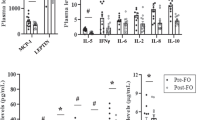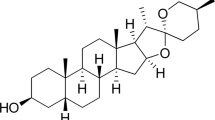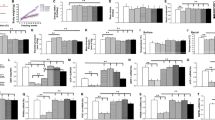Abstract
Background:
Chronically elevated interleukin-6 (IL-6) is implicated in obesity-associated pathologies, where a proportion of this cytokine is derived from adipose tissue. Proinflammatory prostaglandins, which regulate this cytokine elsewhere, are also produced by this tissue.
Objective:
To investigate whether constitutively active cyclooxygenase (COX)/prostaglandin (PG) pathway in white adipose tissue (WAT) is responsible for basal IL-6 production.
Design:
The effect of acetylsalicylic acid (ASA), an inhibitor of COX, on IL-6 was assessed in human subjects and mice. COX, downstream PG synthase (PGS) activity and PG receptor signalling were determined in subcutaneous (SC), gonadal (GN) WAT and adipocytes.
Methods and Results:
In obese humans, low-dose ASA (150 mg day−1 for 10 days) inhibited systemic IL-6 and reduced IL-6 release from SC WAT ex vivo (0.2 mM). Similarly, in mice, ASA (0.2 and 2.0 mg kg−1) suppressed SC WAT 6-keto-PGF1α (a stable metabolite of prostacyclin) and IL-6 release. Although both COX isoforms are comparably expressed, prostacyclin synthase expression is higher in GN WAT, with levels of activity correlating directly with IL-6. Both ASA (5 mM) and NS-398 (COX-2 selective inhibitor ⩽1 μM), but not SC-560 (COX-1 selective inhibitor ⩽1 μM), attenuated IL-6 release from murine WAT in vitro and abolished its depot differences. Prostacyclin receptor (IP) and, to a lesser extent, PGE2 (EP2 and EP4) receptor agonists elevated the release of IL-6 from adipocytes.
Conclusions:
In adipose tissue, constitutive COX-2-coupled prostacyclin triggers the release of basal IL-6, which in obese subjects is significantly dampened by ASA ingestion, thus offering a novel, modifiable pathway to regulate the potentially pathological component of this cytokine.
This is a preview of subscription content, access via your institution
Access options
Subscribe to this journal
Receive 12 print issues and online access
$259.00 per year
only $21.58 per issue
Buy this article
- Purchase on Springer Link
- Instant access to full article PDF
Prices may be subject to local taxes which are calculated during checkout






Similar content being viewed by others
References
Stouthard JM, Romijn JA, Van der Poll T, Endert E, Klein S, Bakker PJ et al. Endocrinologic and metabolic effects of interleukin-6 in humans. Am J Physiol 1995; 268: E813–E819.
Carey AL, Steinberg GR, Macaulay SL, Thomas WG, Holmes AG, Ramm G et al. Interleukin-6 increases insulin-stimulated glucose disposal in humans and glucose uptake and fatty acid oxidation in vitro via AMP-activated protein kinase. Diabetes 2006; 55: 2688–2697.
Ruderman NB, Keller C, Richard AM, Saha AK, Luo Z, Xiang X et al. Interleukin-6 regulation of AMP-activated protein kinase. Potential role in the systemic response to exercise and prevention of the metabolic syndrome. Diabetes 2006; 55: S48–S54.
Yudkin JS, Kumari M, Humphries SE, Mohamed-Ali V . Inflammation, obesity, stress and coronary heart disease: is interleukin-6 the link? Atherosclerosis 2000; 148: 209–214.
Clarke DK, Mohamed-Ali V . Adipokines and insulin resistance. In: O'Rahilly S and Kumar S (eds). Insulin Resistance: Insulin Action and its Disturbances in Disease. John Wiley & Sons: Oxford, UK, 2004, chap 10, pp 269–295.
Schieffer B, Schieffer E, Hilfiker-Kleiner D, Hilfiker A, Kovanen PT, Kaartinen M et al. Expression of angiotensin II and interleukin 6 in human coronary atherosclerotic plaques: potential implications for inflammation and plaque instability. Circulation 2000; 101: 1372–1378.
Burstein SA . Effects of interleukin 6 on megakaryocytes and on canine platelet function. Stem Cells 1994; 12: 386–393.
Biswas P, Delfanti F, Bernasconi S, Mengozzi M, Cota M, Polentarutti N et al. Interleukin-6 induces monocyte chemotactic protein-1 in peripheral blood mononuclear cells and in the U937 cell line. Blood 1998; 91: 258–265.
Caldenhoven E, Coffer P, Yuan J, Van de Stolpe A, Horn F, Kruijer W et al. Stimulation of the human intercellular adhesion molecule-1 promoter by interleukin-6 and interferon-gamma involves binding of distinct factors to a palindromic response element. J Biol Chem 1994; 269: 21146–21154.
Wassmann S, Stumpf M, Strehlow K, Schmid A, Schieffer B, Böhm M et al. Interleukin-6 induces oxidative stress and endothelial dysfunction by overexpression of the angiotensin II type 1 receptor. Circ Res 2004; 94: 534–541.
Mohamed-Ali V, Goodrick S, Rawesh A, Katz DR, Miles JM, Yudkin JS et al. Subcutaneous adipose tissue releases interleukin-6, but not tumor necrosis factor-alpha, in vivo. J Clin Endocrinol Metab 1997; 82: 4196–4200.
Fried SK, Bunkin DA, Greenberg AS . Omental and subcutaneous adipose tissues of obese subjects release interleukin-6: depot difference and regulation by glucocorticoid. J Clin Endocrinol Metab 1998; 83: 847–850.
Fontana L, Eagon JC, Trujillo ME, Scherer PE, Klein S . Visceral fat adipokine secretion is associated with systemic inflammation in obese humans. Diabetes 2007; 56: 1010–1013.
Narumiya S, Sugimoto Y, Ushikubi F . Prostanoid receptors: structures, properties, and functions. Physiol Rev 1999; 79: 1193–1226.
Takaoka Y, Niwa S, Nagai H . Interleukin-1β induces interleukin-6 production through the production of prostaglandin E2 in human osteoblasts, MG-63 cells. J Biochem 1999; 126: 553–558.
Tavakoli S, Cowan MJ, Benfield T, Logun C, Shelhamer JH . Prostaglandin E2-induced interleukin-6 release by a human airway epithelial cell line. Am J Physiol 2001; 280: L127–L133.
Turner MA, Vause S, Greenwood SL . The regulation of interleukin-6 secretion by prostanoids and members of the tumor necrosis factor superfamily in fresh villous fragments of term human placenta. J Soc Gynecol Investig 2004; 11: 141–148.
Richelsen B . Release and effects of prostaglandins in adipose tissue. Prostaglandins Leukot Essent Fatty Acids 1992; 47: 171–182.
Ailhaud G . Cell surface receptors, nuclear receptors and ligands that regulate adipose tissue development. Clin Chim Acta 1999; 286: 181–190.
Jowsey IR, Murdock PR, Moore GB, Murphy GJ, Smith SA, Hayes JD . Prostaglandin D2 synthase enzymes and PPARgamma are co-expressed in mouse 3T3-L1 adipocytes and human tissues. Prostaglandins Other Lipid Mediat 2003; 70: 267–284.
Richelsen B . Factors regulating the production of prostaglandin E2 and prostacyclin (prostaglandin I2) in rat and human adipocytes. Biochem J 1987; 247: 389–394.
Awtry EH, Loscalzo J . Aspirin. Circulation 2000; 101: 1206–1218.
Vane JR . Inhibition of prostaglandin synthesis as a mechanism of action for aspirin-like drugs. Nat New Biol 1971; 231: 232–235.
Kopp E, Ghosh S . Inhibition of NF-kappa B by sodium salicylate and aspirin. Science 1994; 265: 956–959.
Fain JN, Madan AK, Hiler ML, Cheema P, Bahouth SW . Comparison of the release of adipokines by adipose tissue, adipose tissue matrix, and adipocytes from visceral and subcutaneous abdominal adipose tissues of obese humans. Endocrinology 2004; 145: 2273–2282.
Fried SK, Moustaid-Moussa N . Culture of adipose tissue and isolated adipocytes. In: Ailhaud G (ed). Methods in Molecular Biology: Adipose tissue Protocols, Humana Press: Totowa, NJ, USA, 2001. p 155.
Aloisi F, Carè A, Borsellino G, Gallo P, Rosa S, Bassani A et al. Production of hemolymphopoietic cytokines (IL-6, IL-8, colony-stimulating factors) by normal human astrocytes in response to IL-1 beta and tumor necrosis factor-alpha. J Immunol 1992; 149: 2358–2366.
Ikonomidis I, Andreotti F, Economou E, Stefanadis C, Toutouzas P, Nihoyannopoulos P . Increased proinflammatory cytokines in patients with chronic stable angina and their reduction by aspirin. Circulation 1999; 100: 793–798.
Musial J, Undas A, Gajewski P, Jankowski M, Sydor W, Szczeklik A . Anti-inflammatory effects of simvastatin in subjects with hypercholesterolemia. Int J Cardiol 2001; 77: 247–253.
Zailaie MZ . Decreased proinflammatory cytokine production by peripheral blood mononuclear cells from vitiligo patients following aspirin treatment. Saudi Med J 2005; 26: 799–805.
Ridker PM, Cushman M, Stampfer MJ, Tracy RP, Hennekens CH . Inflammation, aspirin, and the risk of cardiovascular disease in apparently healthy men. N Engl J Med 1997; 336: 973–979.
Helmersson J, Vessby B, Larsson A, Basu S . Cyclooxygenase-mediated prostaglandin F2alpha is decreased in an elderly population treated with low-dose aspirin. Prostaglandins Leukot Essent Fatty Acids 2005; 72: 227–233.
Cyrus T, Sung S, Zhao L, Funk CD, Tang S, Pratico D . Effect of low-dose ASA on vascular inflammation, plaque stability, and atherogenesis in low-density lipoprotein receptor-deficient mice. Circulation 2002; 106: 1282–1287.
Schildknecht S, Bachschmid M, Baumann A, Ullrich V . COX-2 inhibitors selectively block prostacyclin synthesis in endotoxin-exposed vascular smooth muscle cells. FASEB J 2004; 18: 757–759.
Obara Y, Kurose H, Nakahata N . Thromboxane A2 promotes interleukin-6 biosynthesis mediated by an activation of cyclic AMP-response element-binding protein in 1321N1 human astrocytoma cells. Mol Pharmacol 2005; 68: 670–679.
Fain JN, Kanu A, Bahouth SW, Cowan Jr GS, Hiler ML, Leffler CW . Comparison of PGE2, prostacyclin and leptin release by human adipocytes versus explants of adipose tissue in primary culture. Prostaglandins Leukot Essent Fatty Acids 2002; 67: 467–473.
Børglum JD, Pedersen SB, Ailhaud G, Negrel R, Richelsen B . Differential expression of prostaglandin receptor mRNAs during adipose cell differentiation. Prostaglandins Other Lipid Mediat 1999; 57: 305–317.
Cipollone F, Fazia ML, Lezzi A, Cuccurullo C, De Cesare D, Ucchino S et al. Association between prostaglandin E receptor subtype EP4 overexpression and unstable phenotype in atherosclerotic plaques in human. Arterioscler Thromb Vasc Biol 2005; 25: 1925–1931.
Holladay CS, Wright RM, Spangelo BL . Arachidonic acid stimulates interleukin-6 release from rat peritoneal macrophages in vitro: evidence for a prostacyclin-dependent mechanism. Prostaglandins Leukot Essent Fatty Acids 1993; 49: 915–922.
Acknowledgements
This work was supported by a Wellcome Trust Collaborative Research Initiative Grant to VM-A and JK (The Wellcome Trust no. 070821/Z/03/Z), from the European Commission (LSHM-CT-2004-005272) and CRDC UCH Grant (award number 44505). MJH was supported by a clinical research fellowship from the Islamic Republic of Iran.
Author information
Authors and Affiliations
Corresponding author
Rights and permissions
About this article
Cite this article
Ogston, N., Karastergiou, K., Hosseinzadeh-Attar, M. et al. Low-dose acetylsalicylic acid inhibits the secretion of interleukin-6 from white adipose tissue. Int J Obes 32, 1807–1815 (2008). https://doi.org/10.1038/ijo.2008.190
Received:
Revised:
Accepted:
Published:
Issue Date:
DOI: https://doi.org/10.1038/ijo.2008.190



